Occupational environment monitoring at a monosodium glutamate (MSG) manufacturing factory
99,000 ₫
Note: The above price is calculated for one sample, and the price may fluctuate depending on the area of the environment to be monitored and market movements. For more accurate pricing support, please refer to the price list or contact our consulting staff directly.
Monitoring the environment of a monosodium glutamate (MSG) production factory is a session of collecting, analyzing, and evaluating workplace factors that may be harmful to workers health.
Table of Contents
Toggle1. Overview of the Monosodium Glutamate Production Factory
a. What is a monosodium glutamate production factory?
Factory producing monosodium glutamate (MSG) is a manufacturing facility specialized in producing MSG, a food additive used to enhance the savory flavor in dishes and beverages. MSG is typically made from ingredients such as sugar, salt, and sodium-containing compounds like monosodium glutamate or other sweetening additives.
The production process of MSG usually includes steps such as mixing, grinding, shaping, and packaging. The components and proportions of the ingredients may vary depending on the recipe and the factory’s production process.
MSG production factories usually comply with food safety and quality regulations and apply strict quality control measures to ensure that the final product meets safety and quality standards.

b. Production stages in a monosodium glutamate factory
The production stages in a monosodium glutamate factory may include the following steps:
- Raw material preparation: Main ingredients such as sugar, salt, monosodium glutamate (MSG), and other additives are prepared and quality-checked before use.
- Mixing and grinding: Ingredients are mixed and ground using specialized machinery to ensure uniformity and fine texture.
- Cooking: The mixed and ground ingredients are cooked in pots or cooking equipment. This process helps dissolve the components and form monosodium glutamate.
- Cooling and drying: After cooking, MSG is cooled and dried to form a powder or granulated product.
- Quality control: Samples are taken from the production process for quality inspection to ensure the product meets compositional and quality standards.
- Packaging: MSG that passes quality inspection is packaged in suitable containers such as plastic bags, jars, or cardboard boxes.
- Final inspection and boxing: Packaged MSG units undergo final inspection and are boxed, ready for transport and distribution.

c. Machinery used in a monosodium glutamate factory
In a monosodium glutamate factory, various specialized machines are used to perform the production stages. Below are some common machines used in MSG production:
- Mixing machine: Used to mix the main ingredients like sugar, salt, MSG, and other additives into a uniform blend.
- Grinding machine: Used to grind ingredients into a fine powder.
- Cooking pots: Used to cook the mixed ingredients to dissolve and produce MSG.
- Cooling and drying machines: Used to cool and dry MSG after cooking to form powder or granules.
- Packaging machines: Automatic or semi-automatic machines used to package MSG into suitable containers such as plastic bags, jars, or cardboard boxes.
- Quality inspection machines: Used to test samples from the production process to ensure the product meets compositional and quality standards.

d. Occupational diseases for workers in a monosodium glutamate factory
Workers in a monosodium glutamate factory may be exposed to harmful factors that can cause occupational diseases. Some common occupational health risks include:
- Respiratory diseases: Workers may experience respiratory issues due to exposure to dust and fumes from MSG production. Inhaling these particles can irritate the respiratory tract, cause pneumonia, or other respiratory problems.
- Skin diseases: Contact with chemical compounds during MSG production may cause skin irritation, dermatitis, or allergic reactions. For example, exposure to cleaning agents, solvents, or other chemicals may damage the skin.
- Vision issues: Environmental factors such as inappropriate lighting or strong reflections can cause eye strain, eye pain, or vision difficulties.
- Hearing issues: Continuous noise from machinery and equipment in MSG production can negatively affect workers’ hearing. Other factors such as vibration may also contribute to hearing problems.
- Cardiovascular issues: Environmental factors like work pressure, stress, temperature, and humidity may impact workers’ cardiovascular health.
To ensure safety and protect workers’ health, appropriate personal protective measures and environmental controls must be applied in MSG factories.

e. Common types of monosodium glutamate on the market
On the market, there are various types of MSG used in cooking and food processing. Some common types include:
- Regular MSG: The basic and most common type, usually made from monosodium glutamate (MSG) combined with salt and other food additives. It enhances savory and umami flavors in dishes.
- Natural MSG: Made from natural ingredients such as vegetables, mushrooms, seafood, seaweed, and herbs. Natural MSG does not contain synthetic MSG or chemical additives.
- Organic MSG: Produced from organic ingredients, meaning no chemicals, synthetic fertilizers, or pesticides are used. Popular among those concerned with health and the environment.
- Sodium-free MSG: An alternative to regular MSG, suitable for those reducing sodium intake. Instead of MSG, sodium-free MSG contains components like potassium chloride, glutamic acid, natural sweet compounds, or other flavorings.
- Vegetarian MSG: Made for vegetarians or those following a plant-based diet. Typically free of animal-derived ingredients and based on natural plant materials such as vegetables, mushrooms, seaweed, and plant-based additives.
- Multi-purpose MSG: Combines various ingredients to provide rich and diverse flavors. In addition to MSG, it may include spices, herbs, flavor blends, and other food additives.
2. Overview of Occupational Environment Monitoring Services
a. What is occupational environment monitoring at a monosodium glutamate factory?
Occupational environment monitoring (or workplace environmental assessment) at a monosodium glutamate factory involves collecting, evaluating, and analyzing measurements of workplace environmental factors. The purpose is to take timely measures to reduce environmental hazards affecting workers’ health and prevent occupational diseases. Monitoring the occupational environment is mandatory for MSG production factories.
Occupational environment monitoring plays a critical role in maintaining, protecting, and improving workers’ health, as employees are the primary resource of a business and directly generate profit. Workers who are regularly exposed to risks or occupational hazards above permitted levels may suffer health issues and develop occupational diseases.
REGISTER FOR OCCUPATIONAL ENVIRONMENT MONITORING SERVICE
b. Nam Viet’s occupational environment monitoring program
Nam Viet’s occupational environment monitoring program is developed by monitoring engineers specializing in occupational safety and environmental protection. Aimed at ensuring worker health and safety, this program uses modern measurement methods to monitor air quality, water, microclimate, physical factors, dust, and other environmental elements in the workplace. This program is vital to maintaining a safe work environment and protecting worker health.
Additionally, Nam Viet’s monitoring program plays a crucial role in researching and developing new solutions to improve workplace environmental quality. With the dedication and professionalism of its monitoring experts, Nam Viet’s exclusive program represents a breakthrough in occupational safety and environmental management in Vietnam.

c. Standardization in occupational environment measurement procedures
Standardization in Nam Viet’s workplace environment measurement procedures is crucial to ensuring accurate and reliable results. The program uses recognized standards and standardized procedures from the Ho Chi Minh City Department of Health. This ensures that collected data can be reliably used for workplace environment assessment and for making decisions to improve workplace conditions and protect workers’ health.
These standardized procedures also ensure that measurements are conducted by a team of highly qualified monitoring specialists with years of experience, enabling managers and experts to trust results from An Toan Nam Viet and make accurate, valuable decisions for worker health and environmental protection.
By applying standardization in occupational environment measurements, Nam Viet demonstrates its commitment to ensuring a safe work environment, protecting workers’ health, and contributing positively to the advancement of occupational safety and environmental management in Vietnam.
d. Occupational environment monitoring report at a monosodium glutamate factory
The monitoring results are prepared according to Form No. 04, Appendix III issued with Decree 44/2016/ND-CP and prepared in two copies: one sent to the workplace that contracted the monitoring service, and one retained by the organization conducting the monitoring.
The storage period for occupational environment monitoring results is unlimited, as regulated by law.

e. Frequency of occupational environment monitoring according to the law
According to Clause 2 of Article 18, Law on Occupational Safety and Hygiene 84/2015/QH13, employers must organize workplace environment monitoring to evaluate harmful factors at least once a year.
f. Deadline for submitting occupational environment monitoring reports according to the law
The report submission deadline is before December 31 each year. Enterprises operating production facilities are required to submit occupational environment monitoring reports to the local Department of Health where the main office and the workers’ workplaces are located.
When there are changes in technology, production processes, or when renovating or upgrading facilities that may introduce new hazardous factors affecting workers’ health, enterprises must update occupational hygiene records related to the harmful factors that require monitoring.
g. Penalties for violations regarding occupational environment monitoring for employers
According to Article 27 of Decree No. 12/2022/ND-CP dated January 17, 2022, on administrative penalties in labor, social insurance, and Vietnamese workers working abroad under contracts:
- Clause 2: A fine of 2,000,000 – 5,000,000 VND for employers who fail to publicly disclose monitoring results to employees at the workplace immediately after results are obtained.
- Clause 3: A fine of 20,000,000 – 40,000,000 VND for employers who fail to conduct occupational environment monitoring to control health hazards as required by law.
- Clause 4: A fine of 40,000,000 – 60,000,000 VND for employers who collude with monitoring organizations to commit fraud in monitoring activities but without reaching criminal liability.
3. Environmental Factors Harmful to Workers in Monosodium Glutamate (MSG) Production Factories
In MSG production factories, there are several environmental factors that may be harmful to workers. Below are some common factors that could pose health risks to workers:
- Dust: The MSG production process may generate dust from grinding ingredients. Prolonged inhalation of dust can irritate the respiratory system and cause respiratory problems.
- Chemical fumes: Chemicals used during MSG production may release fumes, contributing to air pollution. Exposure to these fumes can irritate the eyes, skin, respiratory system, and nervous system.
- Noise: Machinery and equipment in MSG factories often generate high levels of noise. Continuous, high-intensity noise can harm hearing, cause stress, reduce productivity, and increase the risk of workplace accidents.
- Temperature and humidity: MSG production may create working environments with high or fluctuating temperature and humidity. Improper conditions can cause discomfort, fatigue, and affect workers’ health and performance.
- Lighting: Inadequate lighting in factories can cause eye strain, visual fatigue, and difficulty concentrating. Too bright or too dim lighting may reduce productivity and disrupt sleep patterns.
- Materials and chemicals: Workers may come into contact with materials and chemicals that can cause skin irritation, allergies, or serious health risks if not handled and stored properly.
REGISTER FOR WORKPLACE ENVIRONMENT MONITORING SERVICE
4. Measures to Improve Working Conditions in MSG Production Factories
To improve working conditions in MSG production factories, the following measures can be applied:
- Dust management: Ensure dust extraction systems function properly during MSG processing to minimize airborne dust. Use vacuum and air filtration systems to maintain a clean and safe working environment.
- Chemical control: Ensure chemicals used in MSG production comply with safety regulations and usage guidelines. Provide adequate personal protective equipment (PPE) such as gloves, safety goggles, and masks to prevent direct exposure to harmful chemicals.
- Noise control: Apply noise reduction measures, such as using noise barriers, soundproof equipment, ear protection, or designing workflows that minimize noise generation.
- Temperature and humidity management: Maintain a comfortable and safe working environment. Use air conditioning, fans, or temperature and humidity control systems to sustain ideal conditions.
- Lighting: Provide appropriate natural and artificial lighting to ensure a bright and well-lit working environment. Avoid glare or excessive brightness using curtains, screens, or light diffusers.
- Training and supervision: Provide training on occupational safety, PPE usage, and safe working procedures. Conduct regular supervision to ensure compliance with safety regulations and measures.
- Periodically conduct workplace environment monitoring in factories to collect and analyze harmful factors for workers and then adjust to reduce risks to prevent occupational diseases.
5. Benefits of Periodic Monitoring in MSG Production Factories
An Toan Nam Viet provides businesses with excellent benefits when using workplace environment monitoring services according to Decree 44/2016/ND – CP on management and control of harmful factors in the working environment affecting employees.
- Businesses can proactively control harmful factors in workshops or factories.
- Receive recommendations to minimize harmful factors and improve working environment quality.
- Indirectly protect human resources, the main factor in business development.
- Reduce the impact of occupational diseases on health, thereby minimizing future treatment costs.
- Improving workers’ health ensures product quality and production output.
- Comply with occupational safety laws and avoid legal risks.
- Create credibility and professionalism, enhancing the company’s brand reputation.
Nam Viet’s environmental monitoring service is a solution to minimize occupational disease risks and contribute to a clean, high-quality working environment.

6. National Workplace Environment Monitoring Center
Workplace Environment Monitoring Center of Nam Viet is a professional unit specializing in monitoring and measuring workplace environmental quality across all provinces in Vietnam. With an experienced team of monitoring specialists, the center uses modern equipment to ensure accuracy and reliability.
In addition to monitoring services, the center assists clients in planning, handling, and tracking workplace environmental issues. With the motto “customer-centered,” the center prioritizes client satisfaction, meets all client needs, and commits to providing the best solutions for businesses.
REGISTER FOR WORKPLACE ENVIRONMENT MONITORING SERVICE
With investments in technology, equipment, and human resources, Nam Viet’s monitoring center has become one of the most reputable units in workplace environment monitoring in Ho Chi Minh City with the following objectives:
- We always value our brand reputation and service quality.
- We provide clients with the best and most suitable solutions.
- With a team of experienced Masters and Engineers aiming to protect the environment and benefit businesses.
- With Nam Viet Environmental Monitoring, companies receive professional service and the best cost advantages.
The workplace environment monitoring process at Nam Viet includes the following basic steps:
- Before conducting monitoring, all machinery and equipment are calibrated according to legal regulations.
- Strictly follow the committed monitoring procedures with the Department of Health.
- Report monitoring results honestly to employers.
- If monitoring results indicate unsafe conditions for workers, Nam Viet supports remediation, and the enterprise shall:
- Implement measures to improve working conditions to minimize harmful factor impacts and prevent occupational diseases.
- Organize health check-ups to detect occupational and work-related diseases early for workers in unsafe positions.
- Provide in-kind compensation to workers according to labor law regulations.

7. Workplace Environment Monitoring Price List
To help businesses conduct professional and effective workplace environment monitoring, Nam Viet provides clients with a price list of workplace environment monitoring services with quality and reasonable costs.
- Our price list provides detailed information about the costs of monitoring services, including transportation, measurement, analysis, and reporting. Clients can be confident in the accuracy and reliability of the results.
- We commit to competitive and reasonable pricing while being ready to answer any questions professionally and promptly.
- With Nam Viet’s price list, clients can easily choose service packages suitable for their needs. We guarantee maximum satisfaction with professional service quality.
No comments yet

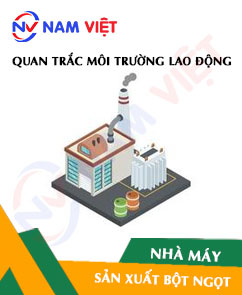
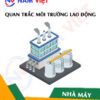
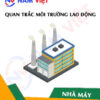


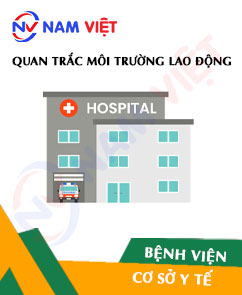


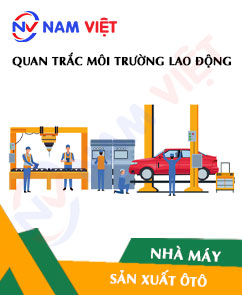
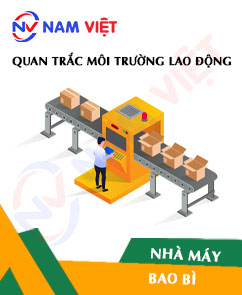

Review Occupational environment monitoring at a monosodium glutamate (MSG) manufacturing factory
There are no reviews yet.